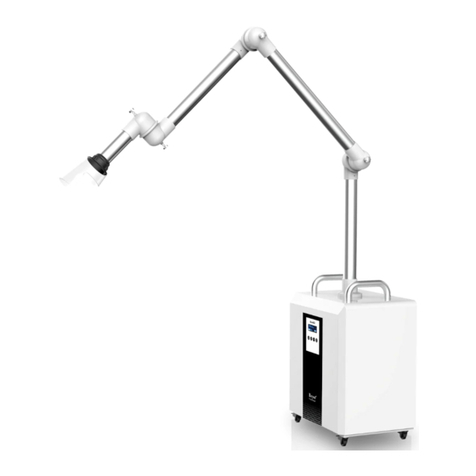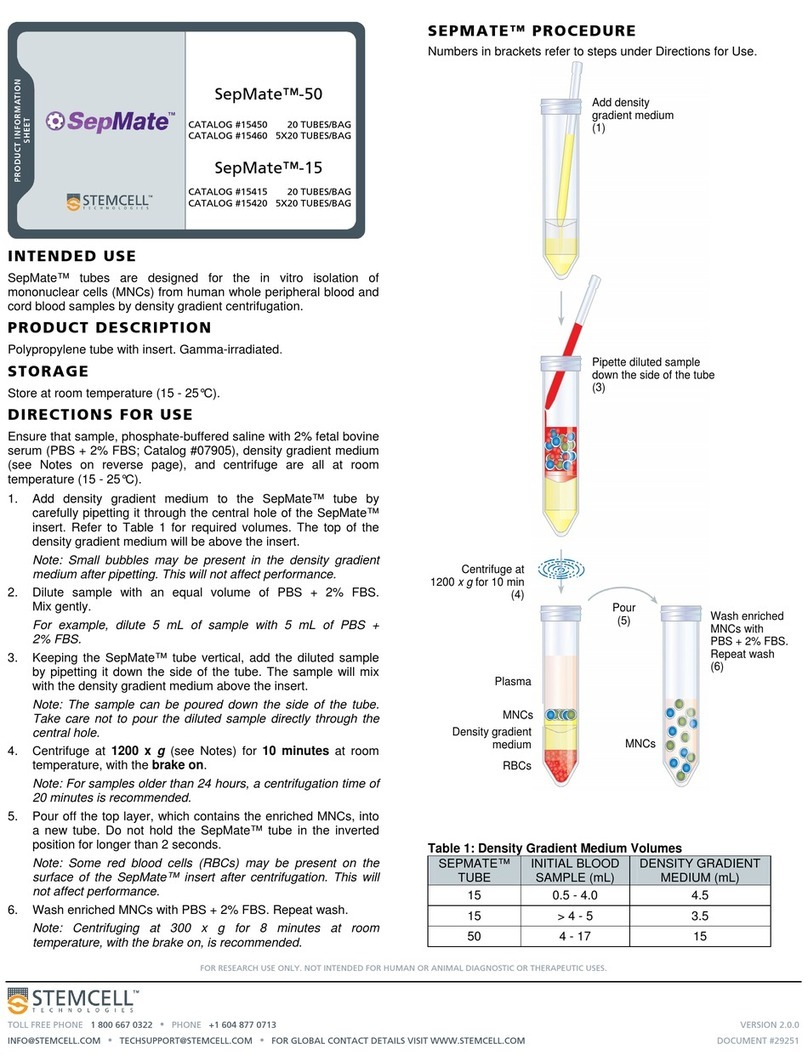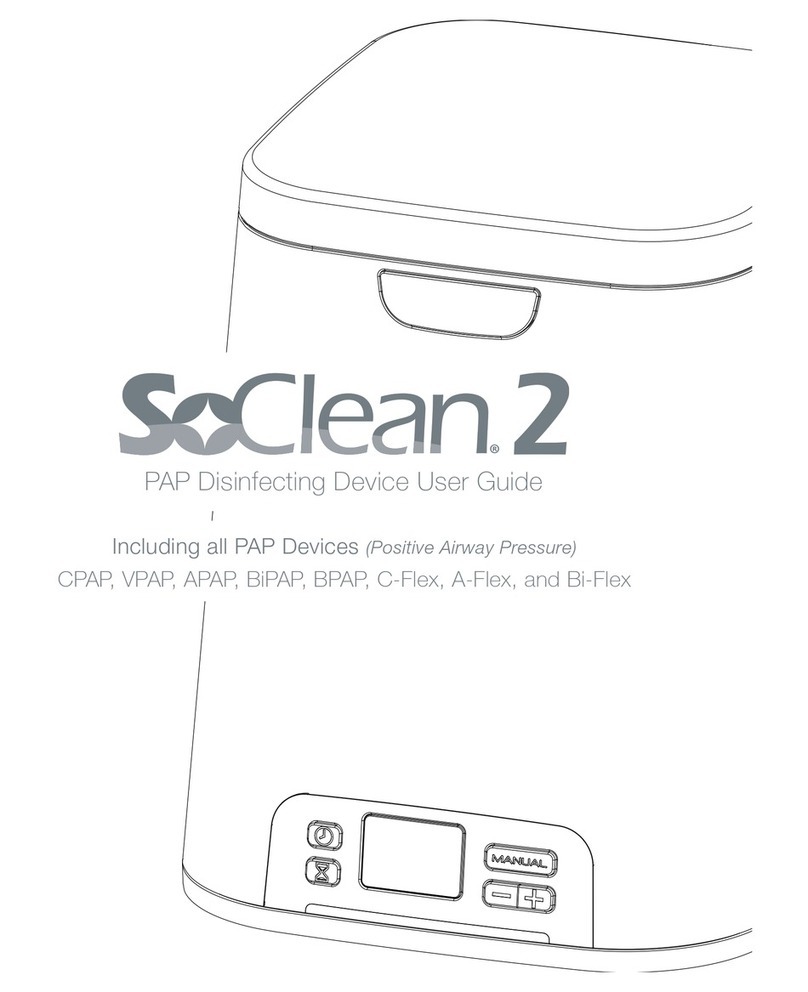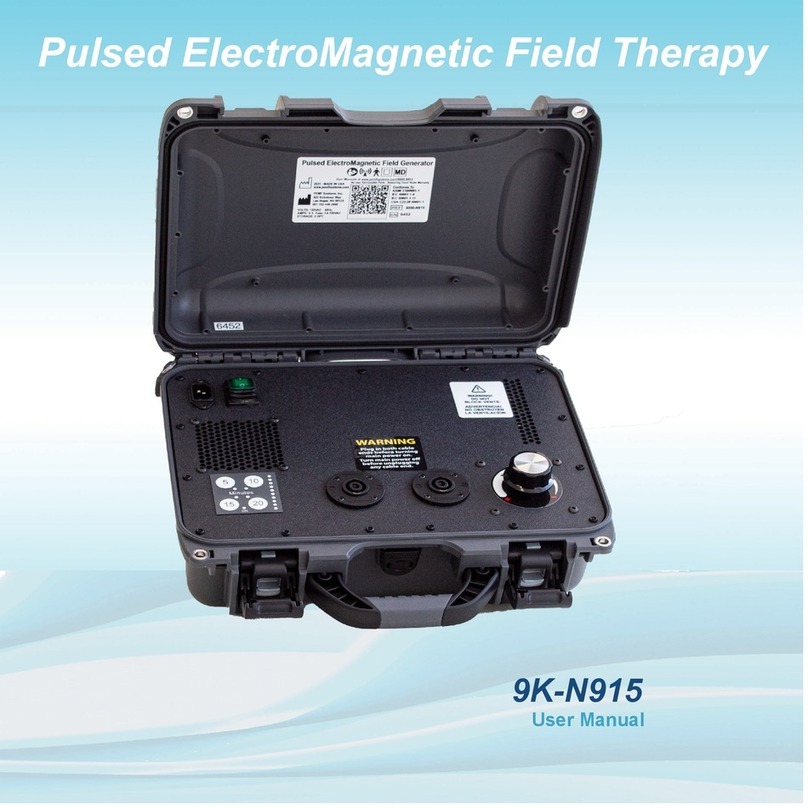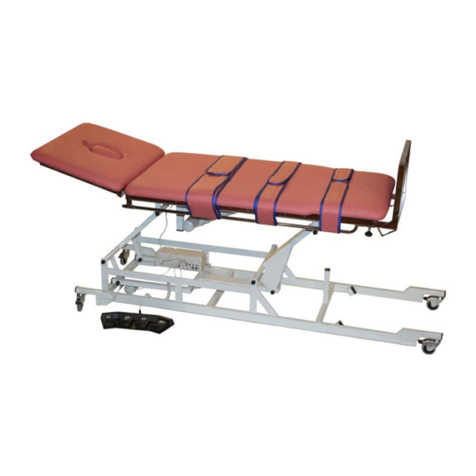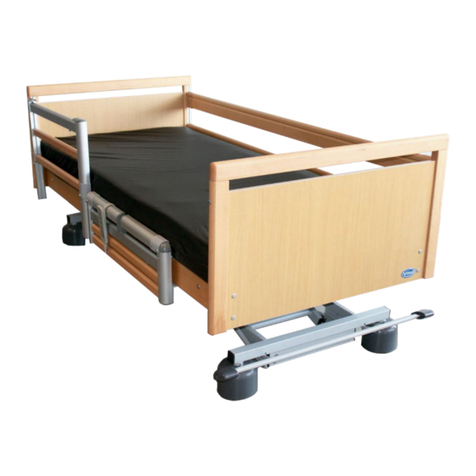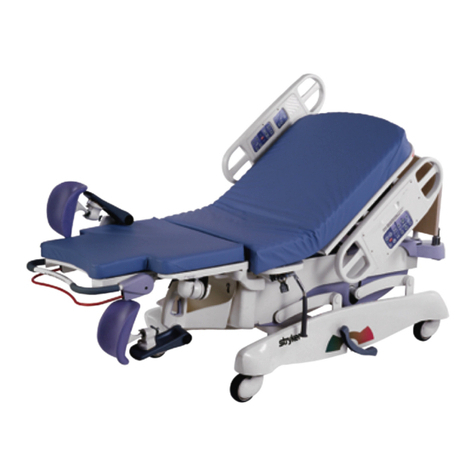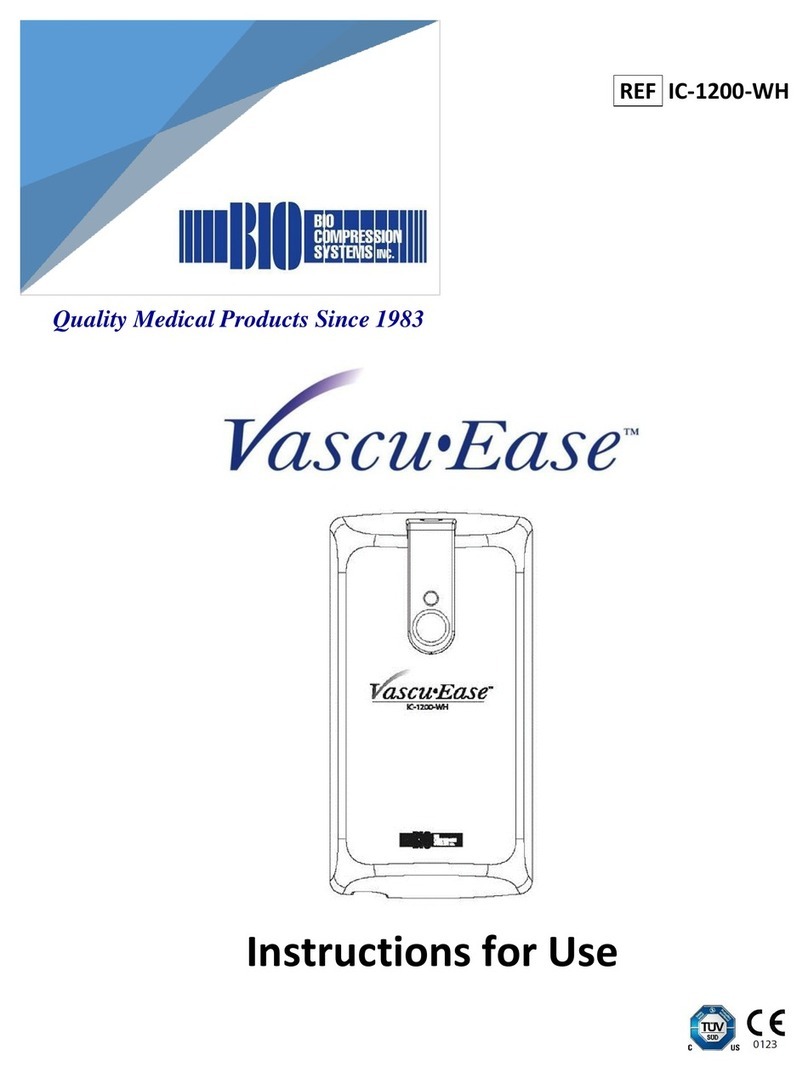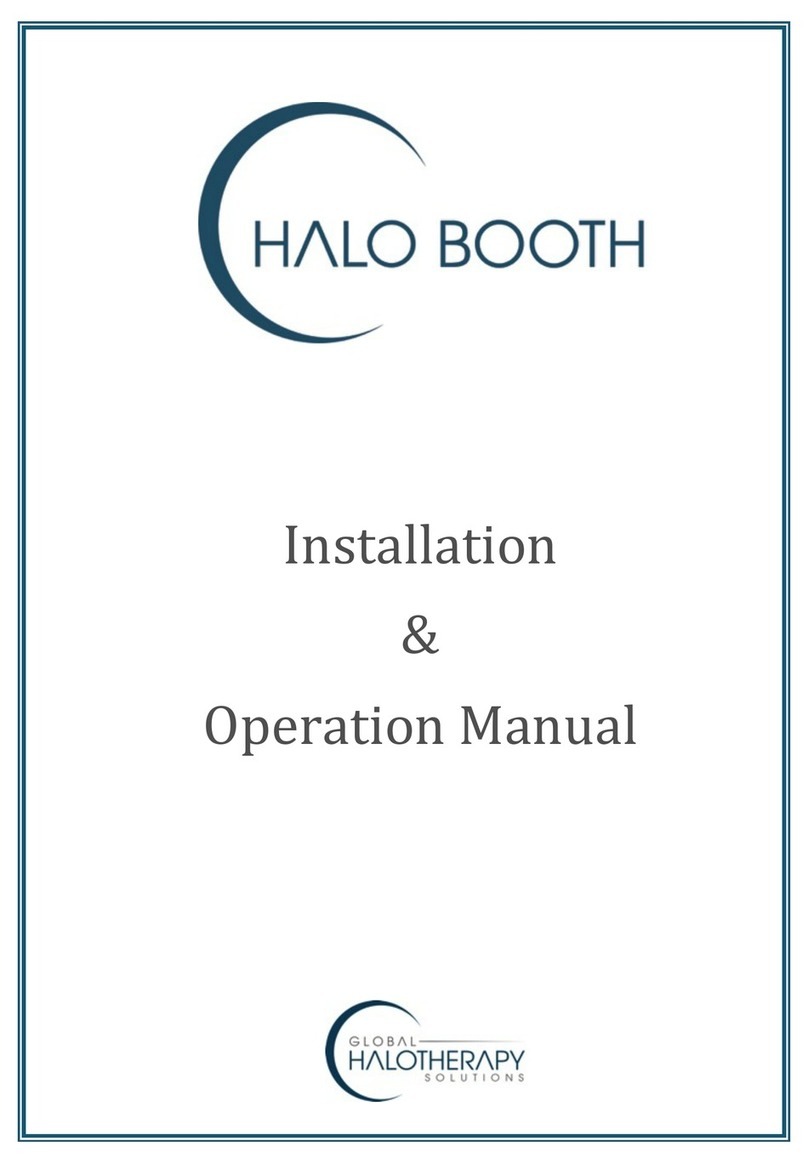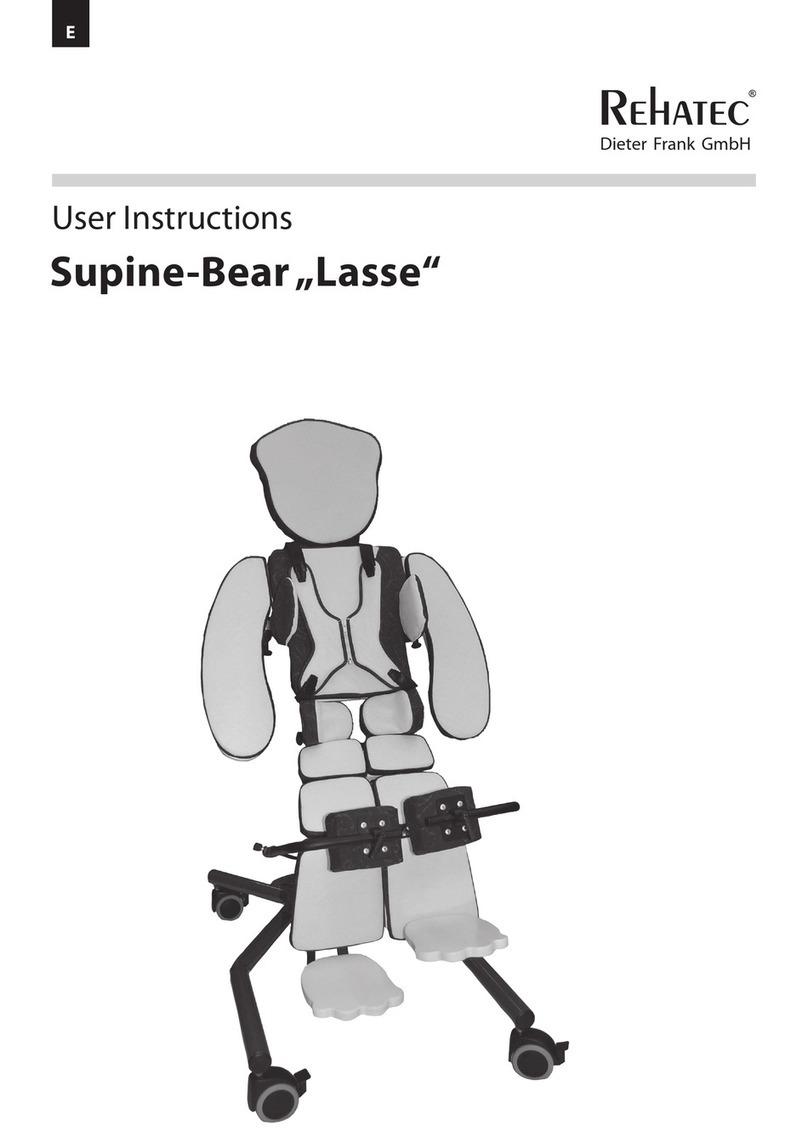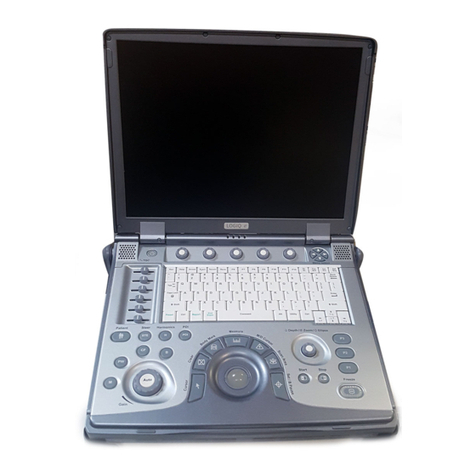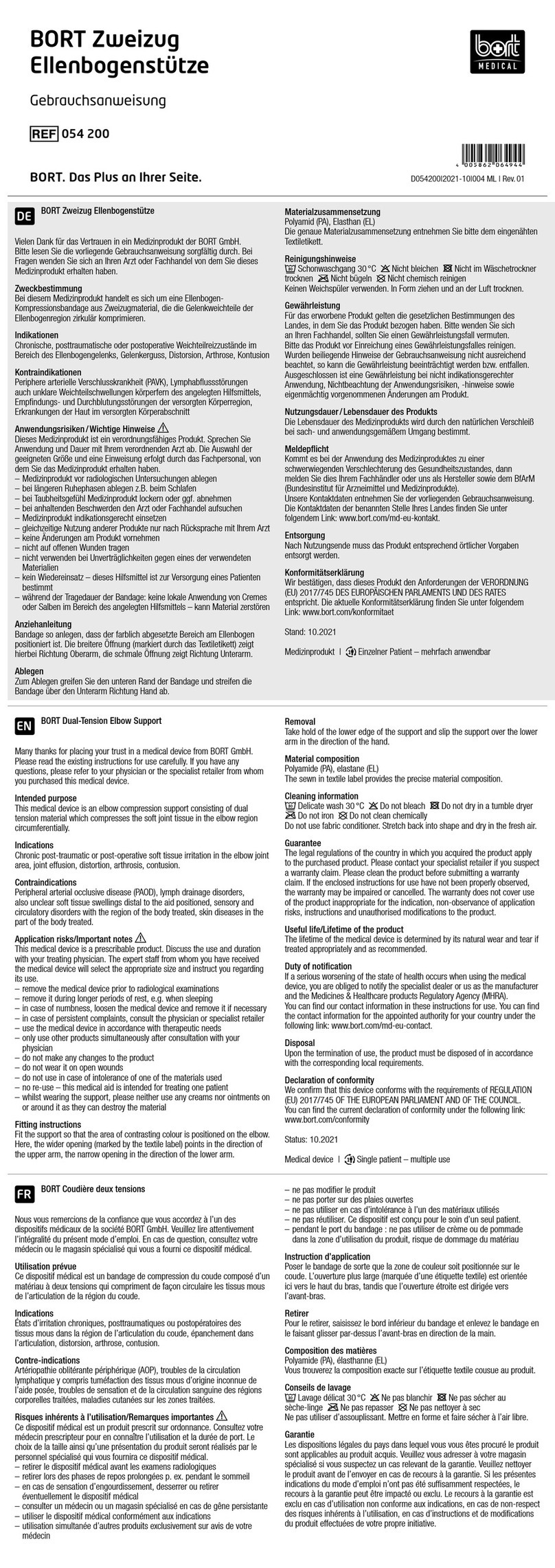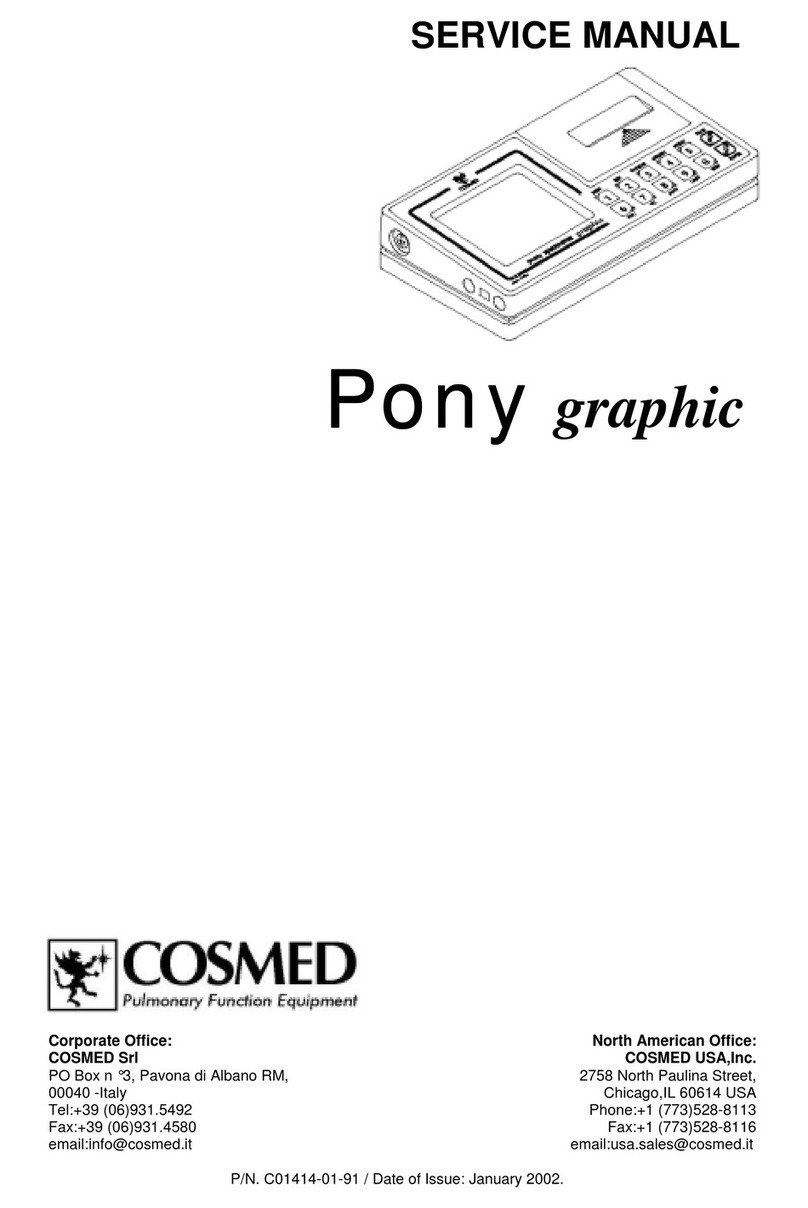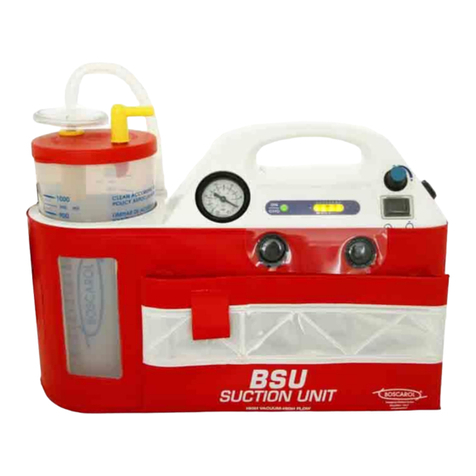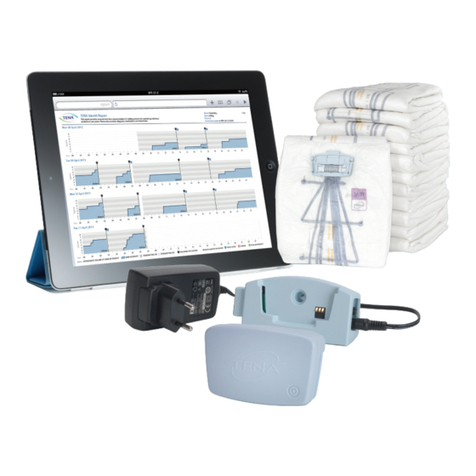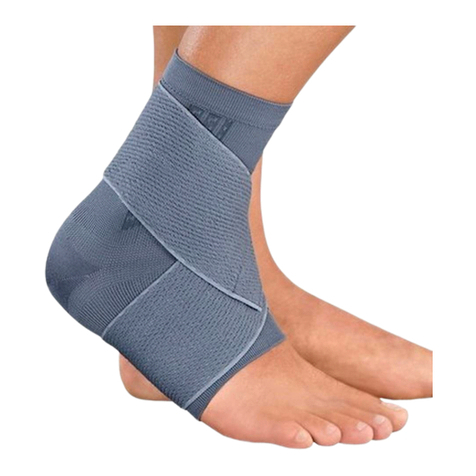DeVillbiss Air Power Company 525DS User manual

DANGER – NO SMOKING
DeVilbiss®5-liter Oxygen COnCentratOr
serViCe Manual
MODEL 525DS
MODEL 525DS-Q
MODEL 525KS
MODEL 525KS-LT
MODEL 525PS
CAUTION
Federal (U.S.A.) law restricts this device to sale by or on the order of a physician.

LT-2023
2
TABLE OF CONTENTS
GENERAL INFORMATION
Introduction.............................................................................................3
Symbol Definitions..................................................................................3
Important Safeguards............................................................................. 4
UNPACKING AND SETUP
Initial Inspection......................................................................................6
Patient Setup.......................................................................................... 6
Operating Instructions ............................................................................6
MAINTENANCE
Patient Alert System...............................................................................8
Alarm Function Testing...........................................................................8
Service Life............................................................................................. 9
Routine Patient Maintenance .................................................................9
Periodic Homecare Provider Preventative Maintenance...................... 10
Provider's Notes ...................................................................................10
Return and Disposal............................................................................. 11
Preventative Maintenance Summary ................................................... 11
TROUBLESHOOTING
System Operation................................................................................. 11
Normal Operating Sequence................................................................12
Low Pressure System ..........................................................................12
Simplified Troubleshooting ...................................................................13
Troubleshooting Chart A....................................................................... 14
Troubleshooting Chart B ......................................................................15
Troubleshooting Chart C ......................................................................15
Troubleshooting Chart D ......................................................................15
Troubleshooting Chart E ......................................................................16
Troubleshooting Chart F.......................................................................16
COMPONENT TESTING, REPAIR, AND REPLACEMENT
Proper Repair Procedures....................................................................17
Cabinet Removal.................................................................................. 17
Accumulator Pressure Test ..................................................................18
Auxiliary Oxygen Port...........................................................................19
Capacitor ..............................................................................................19
Check Valves/Manifold ......................................................................... 19
Compressor..........................................................................................20
Cooling Fan..........................................................................................21
Flow Meter............................................................................................22
Hour Meter ...........................................................................................23
Manifold................................................................................................23
Molecular Sieve Beds...........................................................................23
Power Cord ..........................................................................................24
Power Switch........................................................................................24
Pressure Regulator ..............................................................................24
Printed Circuit Board (PC Board).........................................................25
Rotary Valve ......................................................................................... 25
FIGURES, DIAGRAMS AND PARTS LIST
525DS Unit - Serial #F & 525DS / 525DS-Q Units - Serial #J
(115V Units)..........................................................................................27
525DS Unit - Serial #N & 525DS-Q Unit - Serial #R
(115V Units with Auxiliary Oxygen Port)............................................... 29
525DS Unit - Serial #B & 525DS-Q Unit - Serial #B
(115V Units with Auxiliary Oxygen Port)............................................... 32
525KS Unit - Serial #F & 525KS / 525KS-LT Units - Serial #J
(220/230/240V Units) ...........................................................................35
525KS-LT Unit - Serial #N & 525KS Unit - Serial #R
(220/230/240V Units with Auxiliary Oxygen Port) ................................37
525KS-LT Unit - Serial #B & 525KS Unit - Serial #B
(220/230/240V Units with Auxiliary Oxygen Port) ................................40
525PS Unit - Serial #F & 525PS Unit - Serial #J
(220/230/240V Units) ...........................................................................43
525PS Unit - Serial #B
(220/230/240V Units with Auxiliary Oxygen Port) ................................45
Accessories and Tools..........................................................................47
Pneumatic and Wiring Diagrams..........................................................48
ORDERING INFORMATION AND PARTS RETURN
Ordering Information ............................................................................50
Parts Return .........................................................................................50
WARRANTY......................................................................................... 51
SPECIFICATIONS................................................................................52
ELECTROMAGNETIC COMPATIBILITY INFORMATION...................54

3
LT-2023
GENERAL INFORMATION
INTRODUCTION
This service manual was designed to provide DeVilbiss Healthcare qualied service technicians and homecare providers with the proper maintenance, service, safety,
and repair procedures for the DeVilbiss Oxygen Concentrator.
Read and understand all the information contained in this service manual before attempting to operate or perform any maintenance on the concentrator.
An oxygen concentrator is a device that delivers highly concentrated oxygen for therapeutic applications.
Room air is a mixture of 78% nitrogen, 21% oxygen, 1% argon and other gases. The concentrator draws in room air, separates the nitrogen from the oxygen, and
delivers concentrated oxygen to the patient through an oxygen port.
For more in-depth classroom type training, contact the Respiratory Technical Service Department at 1-800-338-1988 (814-443-4881).
NOTE– DeVilbiss reserves the right to alter or change the design of the DeVilbiss Oxygen Concentrator series. Hence, slight differences in construction or
components may exist between the unit in hand and what is described in this manual.
SYMBOL DEFINITIONS
It is mandatory to read and
understand the operating instructions
prior to use.
This symbol has a blue
background on the product label.
O
I
Off
On LOT Number Manufacturer
Electric Shock Hazard. Cabinet to be
removed by authorized personnel
only.
This symbol has a yellow
background on the product label.
Reset Catalog Number European Representative
Danger - No smoking near patient or
device.
This symbol has a red circle and
diagonal bar on the product label.
Alternating Current Serial Number European Rep CE mark
Use no Oil, Grease or Lubricants
This symbol has a red circle and
diagonal bar on the product label.
Type B applied part Normal Oxygen Keep unit dry.
Do not use near heat or open ames
This symbol has a red circle and
diagonal bar on the product label.
Double Insulated Low Oxygen
Maximum recommended
ow rate: 5LPM
General Warning
This symbol is used throughout
this manual to indicate hazardous
situations to avoid.
Hour Meter Service Required
Important Information
This symbol is used throughout
this manual to indicate important
information you should know.
+5˚C
+35˚C Operating Temperature
Range +5 to +35˚C (+41 to
+95˚F)
C
US
TUV Rheinland C-US
approval mark
Note and Information Symbol
This symbol is used throughout
this manual to indicate notes, useful
tips, recommendations and
information.
Atmospheric Pressure
Range 840 to 1010 hPa
(Approximate sea level to
5000 ft)
TUV Rheinland Certied
approval mark Inmetro approval mark
Federal (U.S.A.) law restricts this device to sale by or on the order of a
physician.
IP21
Ingress Protection - Protected against nger access to hazardous
parts; protected against vertically falling water drops.
This device contains electrical and/or electronic equipment that must be recycled per EU Directive 2012/19/EU- Waste Electrical and Electronic Equipment
(WEEE)

LT-2023
4
GENERAL INFORMATION
IMPORTANT SAFEGUARDS
Read this entire guide before using your DeVilbiss concentrator. Important safeguards are indicated throughout this guide. Pay special attention to all safety information.
Imminently and potentially hazardous information is highlighted by these terms:
DANGER
Indicates an imminently hazardous situation which could result in death or serious injury to the user or operator if not avoided.
WARNING
Indicates a potentially hazardous situation which could result in death or serious injury to the user or operator if not avoided.
CAUTION
Indicates a potentially hazardous situation which could result in property damage, injury, or device damage if not avoided.
IMPORTANT
Indicates important information you should know.
NOTE
Indicates notes, useful tips, recommendations, and information.
DANGER
• Oxygen causes rapid burning. Do not smoke while your oxygen concentrator is operating, or when you are near a person utilizing oxygen therapy.
• Smoking during oxygen therapy is dangerous and is likely to result in facial burns or death. Do not allow smoking within the same room where the
oxygen concentrator or any oxygen carrying accessories are located.
• If you intend to smoke, you must always turn the oxygen concentrator off, remove the cannula and leave the room where either the cannula or mask
or the oxygen concentrator is located. If unable to leave the room, you must wait 10 minutes after you have turned off the oxygen concentrator
before smoking.
• Oxygen makes it easier for a re to start and spread. Do not leave the nasal cannula or mask on bed coverings or chair cushions if the oxygen
concentrator is turned on but not in use. The oxygen will make the materials ammable. Turn the oxygen concentrator off when not in use to prevent
oxygen enrichment.
• Keep the oxygen concentrator and cannula at least 2 m (6.5 feet) from hot, sparking objects or naked sources of ame.
• Open ames during oxygen therapy are dangerous and are likely to result in re or death. Do not allow open ames within 2 m (6.5 feet) of the oxygen
concentrator or any oxygen carrying accessories.
• DeVilbiss oxygen concentrators are equipped with a re mitigating outlet tting that prevents propagation of re into the unit.
WARNING
• To avoid electric shock, do not plug the concentrator into an AC outlet if the concentrator cabinet is broken. Do not remove the concentrator cabinet. The
cabinet should only be removed by a qualied DeVilbiss technician. Do not apply liquid directly to the cabinet or utilize any petroleum-based solvents or
cleaning agents.
• Improper use of the power cord and plugs can cause a burn, re or other electric shock hazards. Do not use the unit if the power cord is damaged.
• Ensure the mains power cord is fully inserted into the concentrator connector (230 volt units) and the power cord plug is completely inserted into a fully
functioning AC wall outlet. Failure to do so may cause an electrical safety hazard.
• See instructions for use regarding re propagation prevention.
• Locate oxygen tubing and power supply cords to prevent tripping hazards and reduce the possibility of entanglement or strangulation.
• Do not lubricate ttings, connections, tubing or other accessories of the oxygen concentrator to avoid the risk of re and burns.
• Do NOT use lubricants, oils or grease.
• Before attempting any cleaning procedures, turn the unit “Off.”
• Use only water-based lotions or salves that are oxygen-compatible before and during oxygen therapy. Never use petroleum or oil-based lotions or
salves to avoid the risk of re and burns.
• Use only spare parts recommended by the manufacturer to ensure proper function and to avoid the risk of re and burns.
• When using the Transller Caddy with a Transll device, always keep the system on a at surface. Disassemble the system prior to moving.

5
LT-2023
GENERAL INFORMATION
WARNING
• If you feel discomfort or are experiencing a medical emergency while undergoing oxygen therapy, seek medical assistance immediately to avoid harm.
• Geriatric, pediatric or any other patient unable to communicate discomfort can require additional monitoring and/or a distributed alarm system to convey
the information about the discomfort and/or the medical urgency to the responsible caregiver to avoid harm.
• Use of this device at an altitude above 13,123 feet (4000 meters) or above a temperature of 95°F (35°C) or greater than 93% relative humidity may
affect the ow rate and the percentage of oxygen and consequently the quality of the therapy. Refer to specications for details regarding parameters
tested.
• To ensure you receive the therapeutic amount of oxygen delivery according to your medical condition, the Oxygen Concentrator must:
• be used only after one or more settings have been individually determined or prescribed for you at your specic activity levels.
• be used with the specic combination of parts and accessories that are in line with the specication of the concentrator manufacturer and that were
used while your settings were determined.
• Your delivery settings of the oxygen concentrator should be periodically reassessed for the effectiveness of therapy.
• For your safety, the oxygen concentrator must be used according to the prescription determined by your physician.
• Under certain circumstances, oxygen therapy can be hazardous. Seek medical advice before using an oxygen concentrator.
WARNING
• Medical Electrical Equipment needs special precautions regarding EMC and needs to be installed and put into service according to the Electromagnetic
Compatibility [EMC] information provided in the accompanying documents.
• Portable and Mobile RF Communications Equipment can affect Medical Electrical Equipment.
MR Unsafe
• Do not bring the device or accessories into a Magnetic Resonance (MR) environment as it may cause unacceptable risk to the patient or damage to the
oxygen concentrator or MR medical devices. The device and accessories have not been evaluated for safety in an MR environment.
• Do not use the device or accessories in an environment with electromagnetic equipment such as CT scanners, Diathermy, RFID and electromagnetic
security systems (metal detectors) as it may cause unacceptable risk to the patient or damage to the oxygen concentrator. Some electromagnetic
sources may not be apparent, if you notice any unexplained changes in the performance of this device, if it is making unusual or harsh sounds,
disconnect the power cord and discontinue use. Contact your home care provider.
• This device is suitable for use in home and healthcare environments except for near active HF SURGICAL EQUIPMENT and the RF shielded room of
an ME SYSTEM for magnetic resonance imaging, where the intensity of Electromagnetic DISTURBANCES is high.
• Use of this equipment adjacent to or stacked with other equipment should be avoided because it could result in improper operation. If such use is
necessary, this equipment and the other equipment should be observed to verify that they are operating normally.
• Portable RF communications equipment (including peripherals such as antenna cables and external antennas) should be used no closer than 30 cm (12
inches) to any part of the oxygen concentrator, including cables specied by the manufacturer. Otherwise, degradation of the performance of this
equipment could result.
CAUTION
• It is very important to follow your oxygen prescription. Do not increase or decrease the ow of oxygen – consult your physician.
• The surface temperature of the exhaust vents on the bottom of the unit may exceed 105.8˚F (41˚C) under certain conditions.
• When device is used under extreme operating conditions, the temperature near the exhaust vents on the bottom of the unit may reach 145˚F (63˚C).
Keep body parts a minimum of 32” (81.2 cm) away from this area.
• Use of harsh chemicals (including alcohol) is not recommended. If bactericidal cleaning is required, a non-alcohol based product should be used to
avoid inadvertent damage.
IMPORTANT
• It is recommended that the homecare provider lock the ow control knob to prevent inadvertent adjustment. A ow setting other than prescribed may
affect the patient therapy.
• Do not service or clean this device while in use with a Patient.
• Installation of 515LF-607 low output ow meter package will cause the low ow alarm to not work and will prevent the device from meeting the
requirements of ISO-80601-2-69:2014 Section 201.13.2.101.
• The Device is classied as IP21 which means it is protected against nger access to hazardous parts and protected against vertically falling water
drops.
• Equipment not suitable for use in the presence of a ammable anesthetic mixture with air or with oxygen or nitrous oxide.
• This device contains electrical and/or electronic equipment. Follow local governing ordinances and recycling plans regarding disposal of device
components.

LT-2023
6
UNPACKING AND SETUP
INITIAL INSPECTION
It is suggested that an initial inspection be performed upon receiving the oxygen
concentrator.
1. After removing the DeVilbiss Oxygen Concentrator from the carton,
examine it for any external damage. If shipping damage has occurred,
contact the DeVilbiss Customer Service Department at 1-800-338-1988
(814-443-4881) for specic instructions. Save the carton for possible later
return; note the position of the unit and placement of the packing material.
2. Check to be sure the intake bacteria lter is in place.
3. Plug the unit into an electrical outlet, turn the unit “On,” and check the
audible and visible alerts.
4. Set the ow meter to maximum recommended liter ow and let the unit
run for at least 20 minutes. Also record the number of hours on the hour
meter.
5. Use an oxygen analyzer to check the concentration.
6. With unit still running, unplug to test the power fail alarm.
NOTE–If the unit fails to operate properly (oxygen concentration not within
specication) or if internal damage is found, contact the DeVilbiss Customer
Service Department at 1-800-338-1988 (814-443-4881).
PATIENT SETUP
1. Position the unit near an electrical outlet in the room where the patient
spends most of his or her time.
NOTE–Do not connect to an electrical outlet controlled by a wall
switch.
2. Position the unit at least 6 inches (16 cm) from walls, draperies, or any
other objects that might prevent the proper ow of air in and out of the
oxygen concentrator.
3. Locate the unit a minimum of 6.5 feet (2 m) from replaces, radiators,
heaters, and hot-air registers.
WARNING
Oxygen causes rapid burning. Do not smoke while your oxygen
concentrator is operating, or when you are near a person utilizing
oxygen therapy. Keep the oxygen concentrator and cannula at least
6.5 feet (2 m) from hot, sparking objects or naked sources of ame.
Electric Shock Hazard. Only qualied DeVilbiss Healthcare homecare
providers may remove the cabinet.
4. Attach the appropriate oxygen accessories (oxygen tubing or humidier)
to the oxygen outlet port.
NOTE–The bubble humidier should be supplied with a permanent re stop
device. If a bubble humidier needs to be used without a permanent re stop
device, a secondary re stop device must be used and placed as close to the
humidier as possible. Failing to do so could increase the risk of re.
NOTE–A maximum of 50 feet (15 meters) of tubing plus 7 feet (2.1 meters)
of cannula plus a bubble humidier is allowed between the concentrator and the
patient.
NOTE– The oxygen supply accessory (patient tubing)
shall be equipped with a means that in case of re stops the
delivery of oxygen to the patient. This means of protection
should be located as close to the patient as practicable.
Oxygen Tubing Only Connection
1. Thread the cannula tting onto the oxygen outlet port.
2. Attach the 5/32” (4 mm) I.D. oxygen tubing.
Oxygen Tubing with Humidification
Connection
If the physician has prescribed an oxygen humidier as part of the patient’s
therapy, follow these steps (If using a prell, go to Step 3.):
1. Fill the humidier bottle with distilled, demineralized, or boiled water. Do
not overll.
2. Thread the wing nut located on the top of the humidier bottle to the
oxygen outlet port so that it is suspended. Make sure it is securely
tightened.
3. Attach the 5/32" (4 mm) I.D. oxygen tubing, not to exceed 50 feet (15
meters), directly to the humidier bottle outlet tting.
NOTE–For optimum performance, the DeVilbiss Oxygen Concentrator has
a preset nominal output pressure of 8.5 psi (58.6 kPa). Use only “bubble-type”
humidiers. Do not use “jet-type” humidiers.
NOTE–Condensation from the humidier may occur in longer lengths of
tubing or if the tubing is laying on a cold oor.
When ready for operation
1. Attach the nasal cannula to the oxygen tubing (per the manufacturer’s
directions).
2. Follow the Operating Instructions.
OPERATING INSTRUCTIONS
1. Remove the power cord completely from the strap. Make sure the power
switch is in the “Off” position.
2. 115 Volt Units– Insert the plug into an electrical outlet. The DeVilbiss
Oxygen Concentrator uses a two-prong polarized plug and is double-
insulated to protect against electric shock.
220/230/240 Volt Units – Ensure cord is connected to the unit before
inserting plug into an appropriate electrical outlet.
WARNING
The plug on the DeVilbiss 525DS concentrators has one blade wider
than the other. To reduce the risk of electric shock, this plug is
intended to t in a wall outlet only one way. Do not attempt to defeat
this safety feature.
Improper use of the power cord and plugs can cause a burn, re, or
other electric shock hazards. Do not use the unit if the power cord is
damaged.
Oxygen causes rapid burning. Do not smoke while your oxygen
concentrator is operating, or when you are near a person utilizing
oxygen therapy. Keep the oxygen concentrator and cannula at least
6.5 feet (2 m) from hot, sparking objects or naked sources of ame.
3. Press the power switch to the “On” position. When the unit is turned “On,”
all three lights (Service Required, Low Oxygen, and Normal Oxygen) on
the front panel will briey illuminate and an audible signal will sound
momentarily. The unit will then operate in "start up" mode with the Low
Oxygen light lit until a normal oxygen level is achieved at which time the
Normal Oxygen light will remain lit. The "start up" may take up to 15
minutes.
NOTE–DeVilbiss recommends for optimal service life that the
DeVilbiss Oxygen Concentrator to be operated for at least 30 minutes
after it is powered on. Shorter periods of operation, operating in extreme

7
LT-2023
UNPACKING AND SETUP
temperature/humidity conditions or in the presence of contaminates, and/
or handling and storage conditions outside those specied, may affect the
long term reliable operation of the product.
4. Slowly turn the ow meter knob until the ow meter ball is centered on the
line next to the appropriate ow rate.
NOTE–When the ow meter knob is turned clockwise, the ow
decreases (and eventually will shut off the oxygen ow). When the knob is
turned counter-clockwise, the ow increases.
NOTE–For prescriptions of 5 LPM, be sure the ball is centered on the
5 liter line; the ball should not touch the red line. Setting the ow higher
than 5 may cause the oxygen purity level to drop.
NOTE–Use low output ow meter (part #515LF-607) for ow rates
under 1 lpm.
NOTE–Installation of 515LF-607 low output ow meter package will
cause the low ow alarm to not work and will prevent the device from
meeting the requirements of ISO-80601-2-69:2014 Section 201.13.2.101.
NOTE–The low-ow alarm may activate if the ow meter ball is set at
or below .5 lpm. The unit will continue to run; however, the Service
Required light will come on accompanied by an audible alarm. Adjust the
ow meter to your prescribed ow.
NOTE–The unit may require up to 20 minutes for the oxygen
concentration and ow rate to stabilize. The ow rate should be monitored
and readjusted if necessary.
5. The ow meter has a locking device. If it is necessary to preset and lock in
the prescribed ow rate, tighten the set screw located on the hex nut just
below the control knob using a 1/16" Allen bit. No adjustment can be made
without loosening the set screw.
6. The DeVilbiss oxygen concentrator is now ready for use.

LT-2023
8
MAINTENANCE
PATIENT ALERT SYSTEM
The DeVilbiss Oxygen Concentrator patient alert system will detect unit
component failure. This system is comprised of both visible and audible alerts
which signal the patient if a malfunction should occur.
DeVilbiss OSD®Operation
The OSD is a device within DeVilbiss concentrators that monitors the oxygen
produced by the unit. The OSD operates as follows:
• Normal Oxygen (green light) - oxygen purity normal
• Low Oxygen (yellow light) - oxygen purity low–requires servicing
If the oxygen purity continues to fall, an audible signal will sound intermittently. If
the oxygen purity continues to fall to a low enough level, the yellow “Low
Oxygen” light will turn off and the red “Service” light will turn on.
NOTE–Refer to the Alerts section below for specic alert settings.
After Power On, the OSD conducts a continuous diagnostic evaluation to check
for a fault in the piezo electronics. If this condition is detected by the OSD
electronics at any time during concentrator operation, the green “Normal
Oxygen” OSD light will turn off and the beeping audible alert and blinking red
“Service” light will activate. Otherwise for the rst fteen minutes of operation,
the green “Normal Oxygen” light will remain illuminated during the oxygen
stabilization process. After that time, the OSD will begin monitoring the oxygen
purity every second.
For units with Serial Numbers
starting with B
After power on, the electronics continuously monitor the oxygen sensor. If a
fault is detected, the green "Normal Oxygen" light will turn off and the beeping
audible alert and blinking red "Service Required" light will activate.
During the rst 15 minutes, the unit will be in “Start Up” mode. The oxygen
purity is continuously monitored and the green "Normal Oxygen" light will turn
on as soon as the therapeutic oxygen levels are obtained. After 15 minutes
stabilization time, if the O2is less than 85% the yellow Low O2LED will be on
and a beeping audible alarm will occur. If the level is below 60% (after
startup) then the yellow and red LEDs will be lit along with a beeping audible
alarm. The audible low O2alarms are blocked during the 15 minute
stabilization delay, and also during the 10 minute stabilization delay that
occurs during turn-down mode enter/exit.
Alerts:
There are two visible service alerts located on the front panel.
For serial numbers starting with
B, J, N or R For serial numbers starting with F
Low O2%Service Low O2%Service
The audible alert system is internally powered; no batteries are required. If the
indicator lights illuminate or the audible alert sounds other than during start-up, a
problem has occurred
• Power Failure (Blinking red “Service” light and pulsing audible alert)
• Low Flow (Below 0.5 lpm) (Continuous red “Service” light and audible alert)
• Below Normal Oxygen (84% to 75%, yellow “Low Oxygen” light. 75% to
60%, yellow “Low Oxygen” light and beeping audible alert. Less than 60%,
red “Service” light and beeping audible alert.)
The visible and audible alerts will activate for approximately 15 minutes in a no
power situation. If the unit is turned “On” without power or power is removed
later, no alert will sound for the rst 10 seconds. After that time, the alert will
produce an audible pulse every few seconds while the visible alert blinks. Power
for this alert is provided by a capacitor on the PC board.
For units with Serial Numbers
starting with B
The audible alert system is internally powered; no batteries are required. If
the indicator lights illuminate or the audible alert sounds other than during
start-up, a problem has occurred
• Power Failure (Pulsing audible alert)
• Low Flow (Below .5 lpm) (Continuous red “Service” light and audible
alert)
Below normal O2:
• The yellow Low Oxygen light will illuminate with an audible alarm at
<85%.
• The yellow Low Oxygen and red Service Required lights will illuminate
with an audible alarm at <60%.
The audible alert will activate for a minimum of two minutes in a no power
situation. There is no visual indicator for this alarm. If the unit is turned “On”
without power or power is removed later, the alert will sound within 10
seconds. After that time, the alert will produce an audible pulse every few
seconds. Power for this alert is provided by a capacitor on the PC board.
NOTE–If the concentrator has been unused for an extended period, the unit
must run several minutes before the power fail alert will activate.
The PC (printed circuit) board is responsible for controlling the system and
alerts.
NOTE–A high pressure condition is indicated by the audible (a “popping”
sound) release of pressure from a pressure relief valve located on the
compressor head.
NOTE–Installation of 515LF-607 low output ow meter package will cause
the low ow alarm not to work and will prevent the device from meeting the
requirements of ISO-80601-2-69:2014 Section 201.13.2.101.
ALARM FUNCTION TESTING
The 525 series is designed to activate alarms when certain conditions or failures
occur. The alarm functions may be tested following the procedures below:
1. Overheating:
a. Remove the front and rear covers from the concentrator; then
disconnect the cooling fan from the printed circuit board.
b. Replace the front and rear covers.
c. Place the concentrator in a location that has an ambient temperature
of approximately 70° F. Then plug the unit into the appropriate mains
voltage and turn it on.
d. Allow the unit to operate until the Service Required Alarm activates,
which should be within approximately two hours.
2. Compressor Failure:
a. Remove the rear cover from the concentrator; then disconnect the
compressor electrical connector from the main wire harness.
b. Plug the unit into the appropriate Mains voltage and turn it on.
c. Allow the unit to operate until the Service Required Alarm activates,
which should be within approximately two minutes.
3. Low Flow / Obstruction of Gas Pathway:
a. Plug the concentrator into the appropriate mains voltage and turn it
on.
b. Allow the device to run for several minutes.
c. Turn the ow meter off so that there is no oxygen owing out of the
unit.
d. Allow the unit to operate until the alarm condition occurs (red light
and audible beep).

9
LT-2023
MAINTENANCE
e. Increase the ow to 1 LPM and conrm that the alarm condition ends.
4. High Flow
a. Connect the oxygen concentrator to AC power and turn the power
switch on.
b. Allow the device to run for several minutes.
c. Adjust the output ow to more than 6.0 LPM using the ow meter
knob (turn counter clockwise until ball goes above 6.0 LPM).
d. The alarm condition (yellow light) should occur.
e. Decrease the ow to 5 LPM and conrm that the alarm condition
ends.
5. Oxygen Generation Mains Failure:
a. Plug the concentrator into the appropriate mains voltage and turn it
on.
b. Turn the ow meter to 5 LPM.
c. Attach another ow meter to the auxiliary oxygen port which is located
on the rear of the concentrator and then adjust the ow to 3 LPM.
d. Allow the unit to operate until the Service Required Alarm is activated,
which should be within approximately thirty minutes.
6. Pressure Failure:
a. Remove the front and rear covers from the concentrator.
b. Disconnect the tubing from the top of one of the sieve beds.
c. Plug the unit into the appropriate mains voltage and turn it on.
d. Turn the ow meter to 5 LPM.
e. Allow the unit to operate until the Service Required Alarm is activated,
which should be within approximately thirty minutes.
7. Power Supply Failure
a. Connect the oxygen concentrator to AC power and turn the power
switch on. Allow the device to run for several minutes.
b. With the power switch in the on position, unplug the AC power cord
from the outlet.
c. The alarm condition (audible beep) should occur and continue for a
minimum of 120 seconds. There is no visual indicator for this alarm
condition.
d. Reconnect the AC power cord and conrm that the alarm condition
ends.
8. Malfunction – O2S Gas Temperature High
a. This alarm condition is tested automatically during start-up.
9. Malfunction – Corrupted Settings
a. This alarm condition is tested automatically during start-up.
10. Malfunction – Non-Recoverable Valve Error
a. This alarm condition is tested automatically during start-up.
11. Malfunction – O2S Oxygen Sensor Communication Failure
a. This alarm condition is tested automatically during start-up.
12. Low Oxygen Concentration – Startup Period
a. Connect the oxygen concentrator to AC power and turn the power
switch off.
b. Leave the device off for several minutes until the outlet ow is zero
(ow meter ball at zero).
c. Turn the power switch to the on position. The alarm condition (yellow
light) occurs during startup until the oxygen concentration reaches
85%.
13. Low Oxygen Concentration – Startup Period Over
a. This alarm condition is tested automatically during start-up. Once the
oxygen concentration reaches 85% the green light comes on.
Service Life
The expected service life of the 525 is 5 years of operation, when used in
accordance with all manufacturer guidance for safe use, maintenance, storage,
handling and general operation. Expected service life of the unit, and in particular
the sieve beds and compressor, may vary based on the operating environment,
storage, handling and the frequency and intensity of use.
ROUTINE PATIENT MAINTENANCE
DeVilbiss recommends using only original DeVilbiss parts and lters in order to
guarantee a reliable operation of the product.
The oxygen patient should perform the following maintenance:
Cannula, Tubing, and Humidifier Bottle
The patient should clean and replace the cannula, tubing, and humidier bottle
according to the manufacturer’s instructions.
Air Filter
NOTE– Recent updates made to the oxygen-generating / ow systems within
the concentrator have eliminated the need for the gross particle lter to be
included on future production units. The lter door has been recongured to allow
for increased air ow through horizontal slots without the ltration material
included.
The redesigned lter door is standard on all 525 models as of October, 2020.
Although the lter is no longer required when using the new lter door, a recess
inside the door has been created, should a provider still desire to have a gross
particle lter included.
The new lter door is backwards compatible with older 525 models.
The maintenance guidelines below should still be followed for those
concentrators that have the gross particle lter.
The air lter should be inspected periodically and cleaned as needed by the user
or caregiver. Replace if torn or damaged. To clean, follow these steps:
NOTE–Frequency of inspection and cleaning of lter may be dependent
upon environmental conditons like dust and lint.
1. Remove the air lter located in the door on the back of the unit.
2. Wash in a solution of warm water and dishwashing detergent.
3. Rinse thoroughly with warm tap water and towel dry. The lter should be
completely dry before reinstalling.
WARNING
Do not attempt to operate the unit without the air lter or while the
lter is still damp.
NOTE–The air lter should be monitored more closely in environments with
abnormal amounts of dust and lint.
CAUTION
Operation of the DeVilbiss Oxygen Concentrator in extreme
environments or without the air lter will prematurely occlude the
intake bacteria lter and cause a decrease in the unit performance.
Exterior Cabinet
The patient should clean the concentrator exterior cabinet weekly by using a
damp cloth or sponge with a mild household cleaner and wiping it dry.
WARNING
Do not apply liquids directly to the cabinet or utilize any petroleum-
based solvents or cleaning agents.

LT-2023
10
MAINTENANCE
PERIODIC HOMECARE PROVIDER
PREVENTATIVE MAINTENANCE
Use only DeVilbiss concentrator replacement parts and accessories.
Every DeVilbiss Oxygen Concentrator is tested at the factory. To assure
continued trouble-free performance, the following preventative maintenance
should be performed by the homecare provider during periodic oxygen patient
visits not to exceed 3 years. Failure to properly maintain the unit will void the
warranty.
1. Check the oxygen concentration with an oxygen analyzer (part #R217P62)
every 3 years.
a. Calibrate the oxygen analyzer prior to checking the oxygen
concentration. The analyzer should be properly calibrated using the
manufacturer’s recommended procedure.
NOTE–Changes in temperature, altitude, or humidity may affect
the analyzer’s oxygen concentration reading. The analyzer should be
calibrated in similar conditions to the location of the concentrator.
b. Power the unit, set the ow meter to 5 LPM and connect the analyzer
to the unit’s oxygen outlet port.
c. Wait 20 minutes for the display to stabilize. The concentrator must
operate for a minimum of 20 minutes before checking the oxygen
concentration.
d. Record the reading.
2. Check the audible alert and indicator lights during every service. When the
power switch is turned “On,” listen for the audible alert and check to see if
the front panel indicator lights are operating.
3. Inspect cabinet air lter (part #303DZ-605) every PM check. Replace if lter
is torn or damaged. Units manufactured since October, 2020 do not have a
gross particle or cabinet air lter. See note under Air Filter on page 9.
4. Inspect intake bacteria lter (part #MC44D-605) during every PM Check.
Replace as necessary.
a. Open the lter door and replace lter as required.
5. Inspect the nal bacteria lter (part #PV5LD-651) during every compressor
service. Replace as necessary.
a. Use the Cabinet Removal instructions found under CABINET
REMOVAL in this manual to remove and attach the cabinets.
b. Remove the hose from each end of the lter and discard the lter.
c. Install the new nal bacteria lter with the “IN” tting toward the ow
meter.
6. Inspect the compressor lter during every compressor service. Replace as
necessary.
NOTE–A change was made to the type of compressor lter used in the 525
series concentrator. The unit may have one of two different types of compressor
lters depending on when the concentrator was manufactured. The original one
is a white plastic lter that is located near the compressor. The newer style is a
sintered bronze lter (525DD-626) that is installed in one end of the compressor
exhaust hose near the rotary valve. All models of the 525 series are now being
manufactured with the sintered bronze compressor lter. See gure below.
Sintered Bronze Compressor Filter
(525DD-626)
NOTE– This PM Schedule reects:
• 5000 hour usage equal to one year
• a normal, clean operating environment.
The homecare provider is responsible for:
• determining the condition of the concentrator operating environment.
• determining a preventative maintenance interval frequency* which takes
into consideration the specic operating environment.
* Standard intervals are noted below. Service interval may be more or
less frequent than stated below provided that the Home Care
Provider establishes and documents appropriate protocols.
7. Inspect AC power cord, power switch and circuit breaker every PM check
or between patients. Replace as necessary.
PROVIDER’S NOTES - Cleaning and
Disinfection When There is a Patient Change
DeVilbiss Healthcare recommends that at least the following procedures be
carried out by the manufacturer or a qualied third party between uses by
different patients.
NOTE – If the following described complete processing of the concentrator by
an appropriately trained individual is not possible, the device should not be used
by another patient.
NOTE – If preventive maintenance is due at this time, these procedures
should be carried out in addition to the servicing procedures.
1. Use disinfectants safely. Always read the label and product information
before use.
2. Always wear personal protective equipment when performing this
procedure. Use suitable gloves and safety glasses. Cover exposed skin on
arms to prevent accidental contact with bleach solution that has been
applied to the concentrator.
3. Dispose of all accessories that are not suitable for reuse. This includes but
may not be limited to the oxygen tubing, tubing connectors, nasal cannula
and/or mask, oxygen outlet connector, and humidier bottle.
4. Clean the exterior of the concentrator with a clean lint-free cloth. Heavy soil
should be removed with a clean lint-free cloth dampened with water. A soft
bristled brush dampened with water can be used to remove stubborn soil.
Dry the concentrator using a clean lint-free cloth if water was used to
remove soil.
5. Use 5.25% chlorine bleach (Clorox Regular Liquid Bleach or equivalent).
Mix one (1) part bleach with four (4) parts water in an appropriate clean
container. This ratio produces a one (1) part bleach to ve (5) total parts
solution (1:5). The total volume (amount) of solution required is determined
by the number of concentrators in need of disinfection. NOTE– An
alternate suitable disinfecting agent (e.g. Mikrobac® forte or Terralin®
Protect) may also be used. Follow disinfectant manufacturer’s instructions.
6. Apply the bleach solution in an even manner to the cabinet and power cord
using a clean lint-free cloth. The cloth should be dampened only and not
dripping of solution. Do not use a spray bottle to apply the solution. Do not
saturate the device with the solution. Take care that no solution enters the
vent areas on the concentrator base or the Auxiliary O2 tting area on the
back of the unit. Avoid over-saturating the cabinet seams so that no
solution residue builds up in these areas. Avoid the caster wells located on
the bottom of the unit.
7. Exposure time of the disinfectant solution should be 10 minutes minimum
to 15 minutes maximum.
8. After the recommended exposure time, all surfaces of the concentrator
should be wiped with a clean lint-free cloth dampened with drinking quality
water no warmer than room temperature. Dry the unit with a dry, clean lint-
free cloth. This is to remove residue that may stain or leave a lm on the
unit, especially after repeated disinfections.
9. Check the cord, the plug on the back of the device, the power switch, the
fuse holder, and the indicator lights for possible damage. Replace all
damaged or worn components.
10. Replace the cabinet air lter on the back of the device.
11. Check the oxygen concentration. If the device is within specication, the
extended life intake bacteria lter does not need to be replaced between
patients. If the oxygen concentration is not within specication, the provider
should refer to the service manual section on Troubleshooting.
12. OPTIONAL INSIDE CLEANING: The concentrator must be disconnected
from the power supply for this step: Open the concentrator and remove all

11
LT-2023
MAINTENANCE
dust deposits inside the cabinet with an appropriate vacuum cleaner. Close
the concentrator.
NOTE – There is no portion of the gas pathways through the concentrator
that could be contaminated with body uids under normal conditions.
The device patient connection may unintentionally become contaminated with
expired gases for a single fault condition i.e., a hose internal to the device
becomes disconnected. This condition will cause no ow out of the device and/or
an alarm condition. Should this occur, refer to the service manual section on
Troubleshooting.
Cleaning
Recommended
cleaning interval
Number of
cleaning cycles *
Compatible cleaning
method
Outer Cabinet 7 days 260 Water, use only a damp
cloth
Air Filter
Units manufactured
since October, 2020
do not have a gross
particle or cabinet air
lter. See note under
Air Filter on page 9.
7 days 104 Mild dish soap (2 tbsp)
and warm water (2
cups)
Oxygen Outlet
Connector
7 days 104 Mild dish soap (2 tbsp)
and warm water (2
cups)
Filter Door Vents 7 days 260 Wipe with dry cloth, or a
cloth dampened with
water to remove dust
* number of cleaning cycles determined by recommended cleaning interval and
expected service life
Disinfection
NOTE–The disinfection process can only be completed by the manufacturer
or by a qualied DeVilbiss provider/service technician.
Recommended
disinfection
interval
Number of
disinfection
cycles
Compatible
disinfection method
Cabinet parts, power cord Between patients 20 1:5 chlorine bleach
(5.25%) and water
solution, Mikrobac
forte, Terralin Protect
Oxygen tubing, tubing
connectors, nasal cannula/
mask, oxygen outlet
connector, humidier bottle,
cabinet air lter
Do not clean,
replace between
patients
N/A N/A
Optional - Inside cabinet Between patients N/A Remove dust with a
vacuum cleaner
RETURN AND DISPOSAL
This device may not be disposed of with household waste. After use of the
device, please return the device to the provider for disposal. This device contains
electrical and/or electronic components that must be recycled per EU Directive
2012/19/EU-Waste Electrical and Electronic Equipment (WEEE). Non-infectious
used accessories (e.g. nasal cannula) can be disposed of as residential waste.
The disposal of infectious accessories (e.g. nasal cannula from an infected user)
must be made via an approved waste disposal company. Names and addresses
can be obtained from the local municipality.
PREVENTATIVE MAINTENANCE SUMMARY
Patient / Caregiver
Clean and replace oxygen tubing, cannula / mask, and humidier bottle (if used)
according to manufacturer’s instructions.
Homecare Provider
During each inspection
• Wash/Replace cabinet lter if applicable.
• Check audible alert and indicator lights.
• Clean lter door vents if applicable.
During each PM check – not to exceed 3 years for the 525 series
• Inspect/Replace intake bacteria lter as necessary.
• Check oxygen purity.
During compressor service
• Inspect/ Replace nal bacteria lter.
• Inspect/ Replace the compressor lter
NOTE– There is no portion of the gas pathways through the concentrator that
could be contaminated with body uids under normal conditions.
The device patient connection may unintentionally become contaminated with
expired gases if a hose internal to the device becomes disconnected. This
condition will cause no ow out of the device and/or an alarm condition. Should
this occur, remove the front cabinet in order to determine where the
disconnection occurred.
Replace all components from the free end of the disconnect through the outlet
port. Reference the pneumatic diagram and replacement part numbers/
instructions.
SYSTEM OPERATION
The DeVilbiss Oxygen Concentrator uses a pressure swing adsorption system.
The air is drawn into the unit through air lters and into a double-head
compressor.
A pneumatic diagram of the system is shown on page 48.
The compressed air passes through a rotary valve, which is cycled at a pre-
determined rate, and is directed into one of two sieve beds. The sieve beds
contain molecular sieve material which is a synthetically-produced inorganic
silicate. It is very porous and has the unique ability to selectively adsorb nitrogen
from the air as it passes through the sieve bed.
As one bed is being pressurized, the other bed is quickly depressurized. This
allows the nitrogen that was adsorbed during its pressurization cycle to be
exhausted from the sieve material.
The nitrogen is released through exhaust ports located on the rotary valve
assembly. The ports are connected to a single piece of hose running from the
valve to the exhaust mufer.
Also during each bed pressurization, a small amount of oxygen ows through an
orice from the pressurized bed into the depressurizing bed. This helps purge the
nitrogen from the depressurizing bed.
The beds will continue to be alternately pressurized and depressurized as the
unit operates.
Oxygen leaving the sieve beds is directed through a check valve to the
accumulator tank. A pressure regulator on the tank controls the oxygen pressure
as it leaves the accumulator and enters the ow meter. The ow meter allows the
oxygen ow to be controlled and adjusted to the level prescribed by the patient’s
physician. From the ow meter the oxygen passes through the nal bacteria lter
and nally the oxygen outlet port to the patient.

LT-2023
12
MAINTENANCE
The DeVilbiss Oxygen Concentrator operates on a timed cycle (3.6 sec. @
5LPM) that is controlled by the PC board. The PC board will send voltage to the
valve causing it to shift and alternately pressurize the sieve beds.
The PC board also activates the electronic alert system. Low ow, system
abnormality, and power failure are indicated by audible and visible alerts. A high
pressure condition will be indicated with a “popping” type sound produced by
release of pressure from a pressure relief valve on the compressor head.
The 525 operating system incorporates “turn-down” technology. The PC board
constantly monitors the ow rate and will decrease the cycle time whenever the
ow rate is less than 1.2 LPM. Therefore it “turns-down” the cycle based on lower
oxygen demand. As a result, the unit runs cooler and less power is consumed.
NORMAL OPERATING SEQUENCE
When the concentrator is turned “On,” the following cycling sequence can be
observed by attaching a pressure gauge to the manifold or accumulator tank test
point.
1. The rotary valve is quickly cycled several times to relieve residual bed
pressure preventing a static condition in the compressor. This rapid cycling
only happens on start-up and is clearly heard as pressure is being quickly
exhausted several times. The pressure exhausts through an exhaust
mufer that is connected to the valve.
2. The PC board applies a short DC voltage signal to the valve. The valve will
stop for several seconds causing the right bed to pressurize rst while the
left bed depressurizes.
3. Voltage is again applied to the valve for a short time. The valve will stop for
approximately a second. During this time the sieve bed pressures are
equalized.
4. A short DC voltage signal is again applied to the valve. The valve will stop
for several seconds causing the left bed to pressurize while the right bed
depressurizes.
5. A short DC voltage signal is again applied to the valve. The valve will stop
for approximately a second. During this time, the sieve bed pressures are
equalized.
6. The cycle then repeats with step 2.
NOTE–In the “turn-down” mode, the xed cycle time is decreased to less
than 2 seconds.
LOW PRESSURE SYSTEM
Changes were made to the 525 series that reduced the internal system pressure
approximately 4 to 5 psi. These changes were implemented in production for all
525 models starting in December, 2019. The change to a lower pressure system
reduces internal temperatures and increases component life.
Starting serial numbers for units with the low pressure system:
• 525DS .............B19C060100DS
• 525DS-Q .........B201130001DQ
• 525KS .............B201020001KS
• 525KS-LT ........Not available at this time.
• 525PS .............B203040001PS
Changes include:
1. PC board was reprogrammed to shorten the cycle time from 3.6 to 2.9
seconds. The shorter cycle time results in lower accumulator tank
pressures as compared to previous units. Therefore it is important to
reference the accumulator tank pressure range chart when measuring tank
pressures. See revised pressure range chart below. Note that pressures
are slightly lower for units that have the low pressure system.
2. A new purge manifold is being used. Internal dimensional changes were
made for the low pressure system. The new manifold has a white top
making it easy to recognize.
3. An orice was added to the tubing connected to the auxiliary oxygen port
on all units having the lower pressure system.
The changes to the parts above require different part numbers. The part numbers
listed below are used only in low pressure system units. Always refer to the parts
list in this manual when ordering service parts.
• 525DD-638 PC board
• 525DD-618 Purge manifold w/white top
• 525DD-645 Auxiliary oxygen port tubing w/orice
NOTE – When servicing 525 models, low pressure system units can be
identied by serial number and manifold color.
TYPICAL PEAK ACCUMULATOR TANK PRESSURE RANGE @ 5LPM
Original System Low Pressure System
Altitude PSI kPa PSI kPa
0 to 457 m
0 to 1500 ft. 23-32 159-221 18-27 124-186
457 to 914 m
1500 to 3000 ft. 21-29 145-200 16-25 110-172
914 to 1524 m
3000 to 5000 ft. 20-27 138-186 13-24 90-165
There will be a pressure swing during each cycle.
• 4 – 5 psi on original system
• 3 – 4 psi on low pressure system

13
LT-2023
TROUBLESHOOTING
SIMPLIFIED TROUBLESHOOTING
The key to simple troubleshooting is to recognize which type of problem exists
and select the most effective approach to solving the problem. The different
types of problems and the approaches for solutions are as follows:
Type I—Purity Issues (Low Oxygen Indicator Light and/or
an audible alert is activated or the Pressure Relief Valve releases
pressure with a ‘popping’ sound).
WARNING
Electric Shock Hazard. Extra care should be taken if it is necessary
to operate the unit with the cabinet removed.
WARNING
Mechanical Hazard. Keep ngers, loose clothing, etc. away when
working on compressor.
Observe the pressure cycle at the oxygen tank.
1. Connect a calibrated pressure gauge to the unit’s oxygen tank test point or
manifold. See accumulator pressure test on page 18.
2. Set the unit’s ow meter to 5 LPM.
3. Power the unit and allow it to operate for a minimum of 5 minutes before
observing the pressure cycle.
4. Compare the high pressures and low pressures to those expected for the
current elevation and use the following chart to nd the appropriate action.
All consecutive high pressures should be within 2 psi of each other and all
consecutive low pressures should be within 2 psi of each other.
NOTE–For normal system pressures refer to Specications.
NOTE–Check for leaks using a certied leak detection solution such as
Snoop® or equivalent (must not contain ethylene glycol). Apply leak test solution
to all ttings and hose connections with unit running. If an air leak is present, the
solution will bubble. All leaks should be repaired before putting the unit back in
service.
CAUTION
Do not apply leak test solution to any part of the rotary valve or the
main PC Board assembly.
Pressure Diagnostic Chart
If Pressure Reading Is Do This To This
Higher than expected and/
or pressure relief valve
has a ‘popping’ noise
Replace Sieve beds (2)
Lower than expected
Inspect and replace, as
needed Filters
Inspect and correct or replace,
as needed Tubing connections
Troubleshoot
Compressor
See Component Testing,
Repair and Replacement
As expected Inspect and correct, as
needed
Leaks from sieve beds to
oxygen outlet port
Dropping too low during
cycle change Replace Check valves or manifold
Uneven - high pressures
& low pressures are not
consistent during cycle
Inspect and replace, as
needed Rotary valve wire harness
Troubleshoot or replace
Rotary valve or PC board.
See Component Testing,
Repair and Replacement
Type II—Operation Issues (Service Indicator Light and/
or an audible alert is activated or the Pressure Relief Valve releases
pressure with a ‘popping’ sound)
WARNING
Electric Shock Hazard. Extra care should be taken if it is necessary
to operate the unit with the cabinet removed.
WARNING
Mechanical Hazard. Keep ngers, loose clothing, etc. away when
working on compressor.
NOTE–Check for leaks using a certied leak detection solution such as
Snoop® or equivalent (must not contain ethylene glycol). Apply leak test solution
to all ttings and hose connections with unit running. If an air leak is present, the
solution will bubble. All leaks should be repaired before putting the unit back in
service.
CAUTION
Do not apply leak test solution to any part of the rotary valve or the
main PC Board assembly.
Operation Alarm Chart
If this is happening It’s because of this Do this to resolve
Pressure relief valve has a
‘popping’ noise with
possible uneven tank
pressure.
Rotary valve not cycling
properly.
Test rotary valve. Refer to page
25.
Defective sieve beds. Replace sieve beds.
Continuous red light with a
pulsing audible alert while
compressor is operating.
Low ow alert – ow setting
below 0.5 lpm.
Correct setting and educate
user and / or install low ow
meter if prescription is below 1
lpm. See section on the ow
meter.
Continuous red light with a
continuous audible alert
and unit is warm to touch.
Internal temperature is too
high.
Move unit to cooler location.
Ensure unit vents are clear.
Ensure unit lters are clean.
Ensure cooling fan is operating,
replace as needed.
Ensure there is proper voltage
to the unit. If voltage is correct,
replace capacitor or
compressor.
Continuous red light with a
pulsing audible alert and
fan is operating but
compressor is not.
Internal power failure to
compressor.
Test voltage at compressor
connector. If no voltage,
replace main wire harness. If
voltage present, replace
capacitor or compressor.
Blinking red light with a
pulsing audible alert and
compressor and fan not
operating.
NOTE–Serial
numbers starting with B
will have audible only.
External OR Internal power
failure.
Ensure voltage is correct and /
or the part is functional for the
following: AC outlet, power
cord, IEC connector or cord
connection, main wire harness,
circuit breaker; correct as
needed. If issue persists,
replace power switch.
Blinking red light with a
pulsing audible alert and
compressor and fan are
operating. Pressure relief
valve has a ‘popping’
noise.
Internal power failure at
valve wire harness or PC
board.
Inspect wire harness and
replace as needed.
Inspect fuse, if blown, replace
PC board. NOTE–Serial
numbers starting with B,
replace PC board.
Type III—The concentrator runs and continues
to cycle but has low oxygen concentrations and
no alarms are activated.
This problem is similar to Type I in the way it is diagnosed/resolved. Observe
pressure cycle at oxygen tank as recommended in Type I.

LT-2023
14
TROUBLESHOOTING
OTHER SYMPTOMS POSSIBLE CAUSE POSSIBLE REMEDY
Pulsating air noise Intake filter not in place or defective Check filter and replace if necessary
Compressor intake hose disconnected Reconnect hose
Excessive noise Loose or defective motor mounts Replace motor mounts
Defective compressor Replace compressor
Defective cooling fan Replace cooling fan
Fluctuating oxygen ow Occluded humidier Clean or replace humidier
Use of improper humidier Use only a bubble-type humidier
Occluded filters Clean or replace filters
Occluded or defective cannula and tubing Detach cannula from oxygen delivery tubing. If proper flow is not
attained, check tubing for kinks or other obstructions. Clean or straighten
as required or replace tubing if necessary
Use of excess oxygen tubing The unit is designed to deliver 5 lpm with a cannula on 50 feet (15
meters) of approximately 5/32” (4 mm) inside diameter tubing. Smaller
diameter tubing or the addition of any other ow restriction may prevent
obtaining the desired ow rate.
Defective ow meter Replace ow meter
Leak in system Check for leaks in all hoses and ttings
Defective compressor Replace compressor
Defective compressor reed valve Replace compressor reed valve
Defective check valve Replace check valve or manifold
Pressure regulator not adjusted properly or defective Adjust or replace pressure regulator
Little or no oxygen ow Flow meter not adjusted properly Adjust ow meter
Hose disconnected to ow meter Reconnect hose
Oxygen delivery tubing is kinked or blocked Straighten tubing or remove obstruction
Occluded humidier Clean or replace humidier
Low oxygen concentration Leak in system Check for leaks in all hoses and ttings
Defective sieve bed check valve Replace check valve or manifold
Defective compressor reed valve Replace compressor reed valve
Defective compressor Replace compressor
Rotary valve not operating correctly Replace valve
Occluded lters Clean or replace lters
Contaminated sieve beds Replace sieve beds
Audible alarm does not sound during power
failure
Unit has not been used for an extended period of time.
NOTE– If the concentrator has been unused for an
extended period, the unit must run several minutes before
the power fail alarm will activate.
Allow unit to run for 20 minutes and retry
Defective PC board Replace PC board
Defective power switch Replace power switch
Defective wire harness Replace wire harness
Audible alarm does not sound when unit is
turned “On”
Defective PC board Replace PC board
Pressure relief valve activated – “popping”
sound
PC board connectors not properly latched Be sure tabs are pushed completely into place
Defective PC board Replace PC board
Defective rotary valve Replace valve
Service Required light does not illuminate when
unit is turned “On”
PC board connectors not properly latched Be sure tabs are pushed completely into place
Defective PC board Replace PC board
Defective light panel Replace light panel (N/A for serial numbers starting with B)
Visible Alarm Audible Alarm Compressor
OFF OFF ON
TROUBLESHOOTING CHART A

15
LT-2023
TROUBLESHOOTING
TROUBLESHOOTING CHART B
Visible Alarm Audible Alarm Compressor
BLINKING PULSING OFF
OTHER SYMPTOMS POSSIBLE CAUSE POSSIBLE REMEDY
Fan off Line cord not properly installed or defective Insert plug in receptacle or replace line cord. On 220/230/240
Volt units, check that the IEC connector on the back of the unit is
attached.
No power at receptacle Check building circuit breaker or fuse, or have house wiring
checked by qualified electrician Circuit may be fully loaded with
other appliances and another receptacle may be required.
Oxygen concentrator circuit breaker activated Press the circuit breaker reset button. If unit circuit breaker opens again,
check internal wiring.
Line cord quick-connect terminal inside unit is
disconnected Reconnect quick-connect terminal
Defective power switch Replace power switch
Defective circuit breaker Replace circuit breaker
TROUBLESHOOTING CHART C
Visible Alarm Audible Alarm Compressor
BLINKING PULSING ON
OTHER SYMPTOMS POSSIBLE CAUSE POSSIBLE REMEDY
Fan and compressor operating
Pressure relief valve activated – “popping”
sound
Connector on PC board not connected Connect connector
Blown fuse on PC board Replace PC board (N/A for serial numbers starting with B)
Defective PC board Replace PC board
Defective valve or valve wire harness. Replace valve or valve wire harness
TROUBLESHOOTING CHART D
Visible Alarm Audible Alarm Compressor
ON ON OFF
OTHER SYMPTOMS POSSIBLE CAUSE POSSIBLE REMEDY
Fan operating Main wiring harness disconnected/defective Reconnect/replace wiring harness
Loose compressor wire Tighten or attach wire
Defective capacitor Replace capacitor
Defective compressor Replace compressor
Unit warm to the touch and cannot be
restarted for several minutes
Compressor overheated due to:
1. Occluded lters 1. Clean or replace lters
2. Restricted input or output air passage 2. Remove obstruction
3. Low or high line voltage 3. Check line voltage; use alternate circuit independent of other
appliances
Defective cooling fan Replace cooling fan
Defective compressor Replace compressor

LT-2023
16
TROUBLESHOOTING
TROUBLESHOOTING CHART E
Visible Alarm Audible Alarm Compressor
ON ON ON
OTHER SYMPTOMS POSSIBLE CAUSE POSSIBLE REMEDY
Fluctuating or no ow System pressure below 9 psi (62.1 kPa) due to:
1. Leak in system 1. Check for leaks in all hoses and ttings
2. Defective compressor 2. Replace compressor
TROUBLESHOOTING CHART F
Visible Alarm Audible Alarm Compressor
SEE BELOW SEE BELOW ON
OTHER SYMPTOMS POSSIBLE CAUSE POSSIBLE REMEDY
No OSD lights are illuminated. Defective OSD. Check concentration with an oxygen analyzer. If the concentration is
within specification, replace the PC board.
Red “Service Required” light is illuminated
accompanied by a beeping audible alarm
Oxygen level is low* Check concentration with an oxygen analyzer. If the concentration is
within specication, replace the PC board. If the concentration is low,
refer to low oxygen concentration symptom in Troubleshooting Chart A.
Defective OSD (for serial numbers starting with
B)
Replace PC board.
Yellow Low Oxygen Light and the Red
Service Required Light are illuminated
accompanied by a beeping audible alarm.
Defective OSD Replace PC board.
Oxygen level is low* (for serial numbers starting
with B)
Check concentration with an oxygen analyzer. If the concentration is
within specication, replace the PC Board. If the concentration is
low, refer to low oxygen concentration symptom in Troubleshooting
Chart A.
Yellow Low Oxygen light is illuminated. Oxygen level is low* Check concentration with an oxygen analyzer. If the concentration is
within specication, replace the PC board. If the concentration is low,
refer to low oxygen concentration symptom in Troubleshooting Chart A.
Yellow Low Oxygen light is illuminated and
an intermittent audible alarm sounds every
few seconds.
Oxygen level is low* Check concentration with an oxygen analyzer. If the concentration is
within specication, replace the PC board. If the concentration is low,
refer to low oxygen concentration symptom in Troubleshooting Chart A.
*Refer to Alerts page for oxygen purity levels.
NOTE–If unit does not run or perform to specication, verify the proper AC input voltage and frequency are being used.

17
LT-2023
COMPONENT TESTING, REPAIR AND REPLACEMENT
PROPER REPAIR PROCEDURES
WARNING
When servicing the DeVilbiss Oxygen Concentrator, be absolutely
certain that the correct tools are used and that the parts are free of
oil and grease or any material not compatible with oxygen. Teon®
tape is recommended and must be applied to the male threads
omitting the rst thread to eliminate the possibility of tape particles
entering the oxygen system.
Electric shock hazard. Do not remove cabinet. The cabinet should
only be removed by a qualied DeVilbiss homecare provider.
Disconnect the power cord from the wall outlet before attempting
repairs on the unit. Extra care should be taken if it is necessary to
operate the unit with the cabinet removed.
NOTE–Be sure to read all of the steps involved before beginning any of the
procedures in this manual.
NOTE–After repairing or replacing a component, run the unit for 20 minutes,
check the oxygen concentration and test for leaks.
The DeVilbiss Oxygen Concentrator is designed for ease of service. To aid
service personnel a Service Kit (part #444-501) is available which contains the
necessary gauges, tools, and testing instruments to properly service the oxygen
concentrator. See list below.
In addition, you will also need an oxygen analyzer (part #R217P62) to
periodically check oxygen concentration levels and leak test solution.
WARNING
A certied leak detection solution, such as SWAGELOK #MS-Snoop®
or equivalent, is needed to test for system leaks. The solution must
not contain ethylene glycol.
CAUTION
Do not apply leak test solution to any part of the rotary valve or the
main PC Board assembly.
NOTE–Apply leak test solution to all ttings and hose connections with the
unit running. If an air leak is present, the solution will bubble. All leaks should be
repaired before putting the concentrator back in service.
The following parts are included in the Service Kit:
1Slotted bit
1#1 Phillips bit
1#2 Phillips bit
1Crescent wrench
18” Duckbill pliers
1 Voltmeter
2Pressure/Vacuum gauge
1Tool box
2Test ttings
1Torx screwdriver w/bits
1Channel Lock pliers
11/4” Ratchet wrench
110mm Socket 1/4 Drive
11/4” Drive extension
1Plastic storage case
CABINET REMOVAL
For units with Serial Numbers starting with B,
J, N or R
To remove back cabinet:
The majority of all the servicing and repairs can be done without removing the
front cabinet completely. However, it may be loosened or removed to gain access
to the components behind it.
1. Unplug the unit from the wall outlet.
2. Remove the six screws that secure the back cabinet – 2 behind handle, 2
near the bottom, and 1 on each side.
NOTE–All six screws are the same size.
3. Remove the back cabinet by sliding it toward the rear until clear.
4. To reassemble, reverse steps 2-3.
To loosen the front cabinet:
5. Remove the two screws (located directly above the hour meter) that hold
the front cabinet to the unit’s internal structure.
6. Remove the screw located near the bottom of the recessed humidier
compartment on the front of the unit. The top of the front cabinet can now
be tilted forward to allow access to the components behind it.
To remove the front cabinet completely:
7. Tilt cabinet forward and disconnect the ribbon connector from the PC
board. Units with serial numbers starting with B do not have a ribbon
connector.
8. Before disconnecting the wires from the power switch and circuit breaker
note their positions in order to reconnect them properly; then disconnect
the wires.
9. Disconnect the hose at the bottom of the ow meter and remove cabinet.
10. To reassemble reverse steps 5 – 9 making sure bottom of cabinet is
inserted securely in base of unit.
NOTE–Two types of cabinet screws have been used in the 525 models
during the past several years, thread-forming screws and machine screws. Take
care not to overtighten the thread-forming screws; they should be torqued to 18 –
20 in-lbs. The machine screws have much ner threads and are used in
conjunction with brass inserts that are molded into the cabinet part; they should
be torqued to 20 – 25 in-lbs.
When replacing a cabinet part such as the front cover, base or compressor box
be sure to use the correct screw. The ne threaded machine screws should
always be used if there is a brass insert. Thread-forming screws should be used
if there is no brass insert molded into the cabinet part.
These screws are not interchangeable, so be sure to order the correct part
number. See gure below.
Thread-forming
Cabinet Screw
(525DD-636)
Machine Cabinet
Screw (525DD-628)
For units with Serial Numbers starting with F
To remove front and back cabinets:
1. Ensure the unit is unplugged from the wall outlet.
2. Remove the six screws that secure the back cabinet – 2 behind handle, 2
near the bottom, and 1 on each side.
NOTE–All six screws are the same size.
3. Remove the back cabinet by sliding it toward the rear until clear.
4. Remove the front cabinet by pushing the top shoulders toward the back of
the unit, then outward away from behind the bib. Tilt the top of the front
cabinet forward until it can be pulled out of the base of the unit.

LT-2023
18
COMPONENT TESTING, REPAIR AND REPLACEMENT
5. To reassemble, reverse steps 2-4.
The majority of all the servicing and repairs can be done without removing the
front bib. However, it may be loosened or removed to gain access to the
components behind it.
To loosen the bib:
6. Remove the two screws (located directly above the hour meter) that hold
the bib to the unit’s internal structure. The bib can now be tilted forward to
allow access to the components behind it.
To remove the bib completely:
7. Disconnect the ribbon connector from the PC board.
8. Before disconnecting the wires from the power switch and circuit breaker
note their positions in order to reconnect them properly; then disconnect
the wires.
9. Tilt the top of the bib forward to release it from the slot in the body of the
concentrator.
10. Disconnect the hose at the bottom of the ow meter and remove bib.
11. To reassemble reverse steps 6 – 10 making sure bottom of front cabinet is
inserted securely in base of unit.
NOTE–The bib tab must be inserted into the slot above the rotary valve
before securing bib.
NOTE–Two types of cabinet screws have been used in the 525 models
during the past several years, thread-forming screws and machine screws. Take
care not to overtighten the thread-forming screws; they should be torqued to 18 –
20 in-lbs. The machine screws have much ner threads and are used in
conjunction with brass inserts that are molded into the cabinet part; they should
be torqued to 20 – 25 in-lbs.
When replacing a cabinet part such as the front cover, base or compressor box
be sure to use the correct screw. The ne threaded machine screws should
always be used if there is a brass insert. Thread-forming screws should be used
if there is no brass insert molded into the cabinet part.
These screws are not interchangeable, so be sure to order the correct part
number. See gure below.
Thread-forming
Cabinet Screw
(525DD-636)
Machine Cabinet
Screw (525DD-628)
ACCUMULATOR PRESSURE TEST
To check accumulator pressures:
1. Make sure the unit is “Off.”
2. Use the Cabinet Removal instructions listed previously to open the unit for
testing.
3. Use the pressure gauge (part #PVO2D-601) and pressure test assembly
(part #303DZ-637) included in the Service Kit.
Pressure Gauge
Pressure Test
Assembly
4. Remove the tubing cap from the accumulator tank tting or from the
manifold attached to the tank, and attach the 1/16" (1.6 mm) diameter
tubing from the gauge to the tting just vacated above.
NOTE–Some manifolds may have a 1/8" ID tting. In such cases, a 1/16" to
1/8" adapter (part #525DD-637) will be needed in order to connect the gauge to
the manifold tting.
See Figures below showing pressures being checked at accumulator tank "T"
tting and manifold.
ManifoldAccumulator "T" Fitting
5. Turn the unit “On” with the ow rate set to maximum recommended ow,
which is 5 lpm. Allow the unit to run for 5 minutes before observing the
pressures. During each timed cycle, the average pressure in the oxygen
accumulator will rise and fall. The high pressures should be consistent and
the low pressures should be consistent.
NOTE–Expected normal pressures observed depend on altitude and ow
rate. See the Expected Accumulator Tank Pressure Range chart below.
• Increases in altitude and ow rate will slightly decrease accumulator
pressures.
• Lower altitudes and ow rates will slightly increase accumulator pressures.
NOTE–A defective check valve, in either the purge harness or the manifold,
may cause a rapid drop in accumulator pressure below the minimum value.
TYPICAL PEAK ACCUMULATOR TANK PRESSURE RANGE @ 5LPM
Original System Low Pressure System
Altitude PSI kPa PSI kPa
0 to 457 m
0 to 1500 ft. 23-32 159-221 18-27 124-186
457 to 914 m
1500 to 3000 ft. 21-29 145-200 16-25 110-172
914 to 1524 m
3000 to 5000 ft. 20-27 138-186 13-24 90-165
There will be a pressure swing during each cycle.
• 4 – 5 psi on original system
• 3 – 4 psi on low pressure system
6. Refer to the Type 1 – Purity Issues, found under Simplied Troubleshooting,
to determine the appropriate action to take in resolving abnormal pressure
cycles.
NOTE–A defective compressor will be indicated by slowly rising pressure.
Pressure may only reach a certain level and then stop.
Low oxygen concentration levels and accumulator pressures higher than normal
may indicate defective sieve beds. Severely contaminated beds may also cause
the pressure relief valve on the compressor to open.
NOTE–A malfunctioning rotary valve may also cause high accumulator tank
pressure and activation of the pressure relief valve. In this case it should be
determined whether the problem is with the sieve beds, valve, or both.

19
LT-2023
COMPONENT TESTING, REPAIR AND REPLACEMENT
AUXILIARY OXYGEN PORT
All 525 series concentrators are now being manufactured with an auxiliary
oxygen port located on the back of the unit. Concentrators with the auxiliary port
have serial numbers starting with B, N or R.
To ll oxygen cylinders:
This external port can be used to ll oxygen cylinders with an FDA-cleared
cylinder lling device that is designed to use oxygen from a concentrator to ll a
cylinder. The port is only for use with FDA-cleared lling devices with compatible
oxygen input specications.The ow meter should be set at 3 LPM or less when
the concentrator is being used during cylinder ll. The port does not affect
concentrator performance if properly used. See gures below.
Auxiliary Port Output Specications:
Outlet Pressure ........................................ <15 psi
Outlet Flow ................................................ 2 LPM
Outlet Oxygen ..............................................>90%
Operation Time ...................................Continuous
Refer to the cylinder lling device instruction guide for the oxygent input/output
specications, connection and operating instructions.
Transfill Hose
(PF1100TUB) Auxiliary Port Transfiller Caddy
(525DD-650)
WARNING
When using the Transller Caddy with a Transll device, always keep
the system on a at surface. Disassemble the system prior to
moving.
CAPACITOR
The capacitor enables the compressor to start and run by supplying voltage to
the windings of the compressor motor. A defective capacitor will result in the
compressor running slower or not starting.
CAUTION
The 525DS concentrators use a GSE compressor with a 22 mfd
capacitor. If replacement is necessary, be sure the correct capacitor
is installed.
CAUTION
The 525KS/525PS concentrators use a GSE compressor with a 10
mfd capacitor. If replacement is necessary, be sure the correct
capacitor is installed.
WARNING
Electric Shock Hazard. When replacing the capacitor, do not touch
the terminals or allow metal objects to come in contact with the
terminals on the capacitor. The capacitor may hold a charge for
several days after the unit is turned off.
If a defective capacitor is suspected, a new one must be installed. The capacitor
is strapped into a well molded into the bottom of the unit next to the cooling fan.
To replace the capacitor:
1. Make sure the unit is unplugged from the wall outlet.
2. Remove the back cabinet. Use the Cabinet Removal instructions listed
previously.
3. Remove the compressor. Use the To Remove the Compressor instructions
listed under Compressor.
4. Disconnect the two wires from the terminals on the capacitor.
5. Cut the nylon cable tie holding the capacitor in place and remove the
capacitor.
6. Reconnect the wires to the new capacitor.
7. Install the new capacitor and secure with a new cable tie.
8. Replace the compressor and reassemble cabinet.
9. Replace the back cabinet and secure with the six screws.
CHECK VALVES/MANIFOLD
Manifold And Sieve Bed Check Valves
The manifold check valves, located in the manifold attached to the accumulator
tank, and the sieve bed check valves, located in the purge harness between the
outlet of each sieve bed and the accumulator tank, allow oxygen to pass from the
sieve beds to the accumulator tank when the bed pressure is greater than the
accumulator tank pressure. These valves also prevent reverse ow of oxygen
from the accumulator tank to the sieve beds.
The manifold also directs a small amount of pressurized oxygen into the
discharging sieve bed to aid the nitrogen exhaust process. The purge harness
includes a xed orice that performs the same function.
A defective manifold or sieve bed check valve will result in lower oxygen
concentrations and accumulator pressures.
Use the Accumulator Pressure Test listed previously to troubleshoot manifold or
sieve bed check valves.
• To replace a defective sieve bed check valve, remove the tubing on either
side of it and install a new valve making sure the outlet end is toward the
accumulator tank.
• To replace a defective manifold check valve, replace the manifold.
NOTE– Also see Manifold section on page 23.
Final Check Valve
The nal check valve is located, on older units, between the nal bacteria lter
and the oxygen outlet tting.
To replace the nal check valve:
1. Make sure the unit is unplugged from the wall outlet.
2. Use the Cabinet Removal instructions listed previously to open the unit.
3. Remove the hose from the outlet side of the nal bacteria lter.
4. Remove the two screws from the back of the oxygen outlet tting assembly
and remove the assembly.
5. Remove the hose from each end of the nal check valve.
6. Attach the hoses to a new check valve. Make sure that the at side of the
check valve is directed toward the oxygen outlet tting.
7. Replace the outlet tting assembly and connect the hose to the lter.
8. Reassemble the cabinet.

LT-2023
20
COMPONENT TESTING, REPAIR AND REPLACEMENT
COMPRESSOR
The DeVilbiss Oxygen Concentrator uses a GSE or Thomas double-head, oil-
free compressor. The compressor is secured to the base with four motor mounts.
Electrical Connector
Exhaust Fitting
Intake Fitting
Pressure Relief Valve
GSE Compressor
Exhaust Fitting
Intake Fitting
Thomas Compressor
Pressure Relief Valve
A compressor that is worn or defective may:
• cause pressure to rise slowly.
• cause excessive noise and/or vibration.
• cause lower oxygen concentrations.
A worn or defective compressor can be caused by a defective internal
component such as:
• reed valve
• o-ring
• gasket
• cup seal
These components are included in the Compressor Rebuild Kit (GSE 525D-643
and 525K-643 or Thomas 525D-653). GSE compressor is shown below.
Sleeve
Valve Plate
Rod Screw Rod (beneath
cup retainer)
Cup Seal
Cup
Retainer
Reed
Valve or
Flapper
Retainer
Intake
Fitting
PR Valve
Compressor
Head
Head
Gasket
Screw
Connecting
Tubes
O-Ring
Spacer
Sleeve
Exhaust
Fitting
NOTE–A built-in thermal cutoff switch will shut the compressor off if it
becomes overheated. This protects the compressor from damage caused by heat
build-up. (Some models have an auxiliary thermostat mounted within the
compressor compartment.) Should this condition occur, the compressor will
require several minutes for the thermo-protective device to reset.
NOTE–A pressure relief (PR) valve is located on the pressure head to
prevent high pressure build up in the system should a component malfunction
occur.
To test the compressor operating voltage:
The compressor requires line voltage to operate. If the compressor does not start
when the unit is turned on, the voltage input must be tested:
1. This voltage can be checked at the compressor connector using a
voltmeter or test light connected to the brown and blue wires. The voltmeter
is the best way to test.
Testing Compressor Voltage
Voltmeter Leads
This manual suits for next models
4
Table of contents
